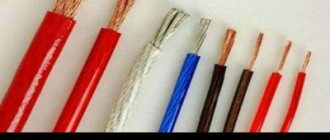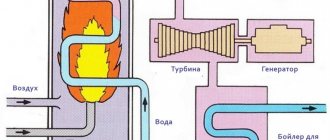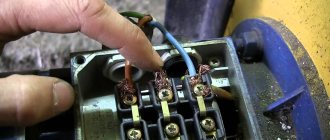— My laptop is electrifying, I feel a slight tingling sensation. Don't know what's wrong?
When I heard a debate about the reasons for this phenomenon for the tenth time among programmers with MacBooks, it became clear that it was time to write an article. Sometimes this effect manifests itself as a slight vibration when the skin and metal parts of the laptop come into contact, sometimes as a tingling sensation.
The short answer: your computer case is running at ~110V (half the mains voltage), but because the current is low, it won't shock you too much.
For electrical engineers, this is a platitude: for the same reasons, in houses with old wiring, a washing machine can shock when you touch the bathtub, a desktop computer case, etc. This topic has been raised many times on the Internet, but still most people do not know about the reasons for this phenomenon. The situation is complicated by the fact that the design of the power supply in European MacBooks does not allow us to get rid of this phenomenon
!
Determination methods
Let's look at ways to determine the neutral and grounding conductors, from very simple to more complex.
The circuit has diff current protection
. If the entire object or branch under study is equipped with differential current protection - a differential current device or an RCD, the task is greatly simplified. You need to connect a control device, for example a lamp with conductors, to the phase and to one of the conductors being tested. If the differential protection does not work, then the lamp is connected to the working zero. If an RCD is triggered when a lamp is connected, you connect it to the phase and ground. Everything is quite simple and at the same time check the residual current device in practice.
Before performing such a test, you need to make sure that the diff protection is working by pressing the “test” button on the protective device. It should be noted that the method will work provided that the current through the lamp exceeds the rated differential current of the device. That is, when using an incandescent lamp (an energy-saving lamp is not suitable), an RCD with a leakage current of 10-30 mA will trip. The introductory RCD for a 300 mA leak may not work; for a reliable test, you need to take a more powerful device.
Comparison with grounding contacts of sockets
. This method will work if there is a two-pole circuit breaker at the input that opens the working zero and there are grounded sockets in the room. The input machine should be turned off, thereby we will open any connection between zero and ground. If possible, unplug all appliances from electrical outlets.
Next, you should “ring” with a multimeter in resistance measurement mode the grounding contact of one of the sockets with the contacts being tested. When connected to the neutral wire, the multimeter should show a high resistance; with a ground contact at an unknown point with the ground of the socket, the resistance is almost zero.
In this way, you can at the same time check the correctness of the connected sockets: when the input two-pole circuit breaker is turned off, the neutral and ground contacts should not ring. Well, this is provided that the wiring is initially in good working order and installed correctly.
Climb into the shield
. If it is not possible to implement the previous methods, you will have to go into the “stuffing” of the electrical panel. I think there is no point in reminding about safety precautions here: no one has canceled it. In fact, the method is quite simple: you need to find the neutral conductor going into the room and disconnect it from the switchboard terminals. Then ring with the contacts being tested: the one with whom the call will be made is the neutral conductor.
In the case of a shield, difficulties may well arise when even in the shield it is difficult to distinguish zero from grounding. In this case, you will need current clamps. It is necessary to turn on the voltage and load in the room, and examine unknown conductors in the shield with clamps - where there will be current and working zero
Please note: the method only works if you know for sure that one of the conductors is zero and the other is ground
All of the methods described above work with both grounding and grounding.
Determine the contacts when connecting an electric stove
. Sometimes it becomes necessary to replace an electric stove socket, but the wiring is from Soviet times or the early 90s, one color. To correctly determine whether an electric stove is zeroed, a condition is necessary - a two-pole circuit breaker in the input switchboard, which disconnects both phase and zero from the entire apartment.
So, with the power turned on, we determine the phase on the terminals under study for the future socket - we mark this contact and throw it aside, then we don’t need it. Then you need to determine the zero in any socket in the apartment - since the wiring is Soviet, there is no ground there, so the zero will be the terminal on which the indicator screwdriver does not light up.
Now we turn off the power to the entire apartment and use a multimeter to dial the zero of a regular outlet with the two remaining contacts for the electric stove. The contact that rings with the zero of the socket is working, and the one that does not ring is zero (ground). If both contacts ring, you need to look for errors in the electrical wiring. When organizing grounding in Soviet times, it was connected to the “PEN” terminal without any switching devices.
How to protect yourself from zero loss
How to deal with this? There are several ways to protect yourself from increased voltage when the zero line breaks.
The first method is to reliably re-ground the neutral conductor. Looking ahead, I’ll say that this method is bad and harmful.
This method can be used in private homes
It doesn’t matter if you have single-phase or three-phase input. The most important thing is to make a high-quality grounding circuit
After this, connect the neutral conductor busbar to this circuit with a separate conductor. In the event of a break in the neutral wire, the power supply to your household appliances will remain in balance and no major imbalance will occur.
The current will flow from the phase through the consumer resistance and go through the zero busbar and its conductor to the ground. And so on for all other phases.
A slight imbalance will of course be present here, but its magnitude will depend on the quality of your ground loop. However, this method of protection has one big drawback that negates all its advantages.
Of course, a grounding loop needs to be made, no one argues with that. The question is whether to connect it to the neutral conductor.
After all, if it is of high quality (10 Ohms or even 4 Ohms) only you have along the entire street, and a break in the neutral wire happens not near your house, but at the very beginning of the overhead line, then all your neighbors will immediately “sit” on this circuit.
In fact, the entire total current will go through your neutral conductor. If you set zero through a two-pole or four-pole circuit breaker, it will most likely break due to overload. Otherwise, expect a fire and melted wiring.
Therefore, a correctly assembled shield (an input circuit breaker selected for the load, grounding a copper conductor with a cross-section of at least 10 mm2) is the key to your safety.
Another disadvantage of such “circuit protection” is the danger of getting energized yourself. Let's say you made a great outline a few years ago.
But due to the presence of salts in the soil, it gradually rotted, and you don’t even know about it.
As a result, with the next neutral break, all grounded electrical equipment in your home will be energized. There is no land anymore. And the phase potential will begin to flow through the instrument housings.
I went to open the refrigerator and got an electric shock; I went into the shower and got electrified.
Therefore, it is more reliable and safe to use another method.
Basic rules for checking grounding
To ensure safe and reliable operation, use a multimeter or tester to check the AC outlets in your home. Before connecting to an AC power source, perform tests on the AC power source.
Namely:
- Turn off the circuit breaker that powers the panel. Attach tag S229-0237 to the switch.
- Use a ground resistance meter to check the resistance between the receiver's ground pin to each of the phase pins. The test checks for short circuits to ground or wiring.
- Use a ground tester to check for infinite resistance between phase pins. The test checks short wiring.
- Use a multimeter to measure the corresponding voltages between phases. Use a multimeter to check that the voltage at the AC outlet is correct.
Apple power supplies
As we have already found out, voltage appears on the case only if the devices are connected to an outlet without grounding. There are many such sockets in houses with old wiring, where there is simply no grounding in the sockets.
However, even in buildings with modern wiring, where the sockets have properly connected grounding, for some reason MacBooks continue to receive electric shock. It's all about the features of Apple power supplies.
Ground pin on the MacBook's power supply. This contact is connected to the laptop body.
All MacBook power supplies have removable plugs for different countries. You can only carry a small adapter with you when traveling and change it if necessary. Included with a MacBook there is always a short plug that is inserted directly into the case and a long plug on the wire. So, in European, American and Chinese short plugs there is no grounding contact. It is only available in UK plug.
The short European Apple plug does not have a ground pin
UPD: the British short plug also does not have a ground pin
inside, although there is a ground plug. Proof.
And only the extended plug with cable has a grounding contact. This can be checked by looking at the place where the plug attachment is attached to the power supply; inside there should be contacts that clamp the grounding washer. If they are not there, the laptop is guaranteed to receive an electric shock. This is often found on Chinese counterfeit power supplies, even on an extended socket with a cable.
Ground pin inside detachable plug
How does grounding work?
Multimeters are sometimes called digital voltmeters. They are capable of making a wide range of electrical measurements. Most models have a large LCD display on the top, a set of 3 connections on the bottom for test probes, and a dial in the middle. To test an electrical outlet, you only need to use the AC voltage setting.
Peculiarities:
- The presence of meter test leads usually means red and black colors.
- There is a short, thick connector called a plug at one end, and narrow, sharp metal probes with hard plastic handles at the other.
- To measure data, insert the black plug into the socket marked "COM" on the meter.
- One of the remaining 2 connectors should have a "V" for voltage, and the Greek letter omega, which looks like a horseshoe, symbolizes resistance.
- You need to find this connector and connect the red wire to it.
Look at the scale on the meter and determine the AC voltage setting. Some models have separate settings for AC and DC voltage, while others have a single setting and a button that allows you to switch between current settings.
Most outputs are polarized, meaning one slot is wider than the other. The wider slot is negative or ground, and the narrower slot is voltage.
Insert the black wire into the wider slot and the red wire into the narrower slot. The display should show 109 to 121 volts, the standard range.
Why does this matter and why is it so important? This is not a problem for lamps or other simple electrical devices, but it can cause problems for complex electronics. Then remove the black probe from the wide socket, and move it to the round (ground) socket at the bottom of the socket. The voltage should be the same. Finally, insert one probe into the wider neutral slot and the other into the round ground. The voltage should be zero
Ordinary light bulbs may not be damaged if there is no grounding, but electrical appliances may fail.
Determination methods
Let's look at ways to determine the neutral and grounding conductors, from very simple to more complex.
The circuit has diff current protection
. If the entire object or branch under study is equipped with differential current protection - a differential current device or an RCD, the task is greatly simplified. You need to connect a control device, for example a lamp with conductors, to the phase and to one of the conductors being tested. If the differential protection does not work, then the lamp is connected to the working zero. If an RCD is triggered when a lamp is connected, you connect it to phase and ground. Everything is quite simple and at the same time check the residual current device in practice.
Before performing such a test, you need to make sure that the diff protection is working by pressing the “test” button on the protective device. It should be noted that the method will work provided that the current through the lamp exceeds the rated differential current of the device. That is, when using an incandescent lamp (an energy-saving lamp is not suitable), an RCD with a leakage current of 10-30 mA will trip. The introductory RCD for a 300 mA leak may not work; for a reliable test, you need to take a more powerful device.
Comparison with grounding contacts of sockets
. This method will work if there is a two-pole circuit breaker at the input that opens the working zero and there are grounded sockets in the room. The input machine should be turned off, thereby we will open any connection between zero and ground. If possible, unplug all appliances from electrical outlets.
Next, you should “ring” with a multimeter in resistance measurement mode the grounding contact of one of the sockets with the contacts being tested. When connected to the neutral wire, the multimeter should show a high resistance; with a ground contact at an unknown point with the ground of the socket, the resistance is almost zero.
In this way, you can at the same time check the correctness of the connected sockets: when the input two-pole circuit breaker is turned off, the neutral and ground contacts should not ring. Well, this is provided that the wiring is initially in good working order and installed correctly.
Climb into the shield
. If it is not possible to implement the previous methods, you will have to go into the “stuffing” of the electrical panel. I think there is no point in reminding about safety precautions here: no one has canceled it. In fact, the method is quite simple: you need to find the neutral conductor going into the room and disconnect it from the switchboard terminals. Then ring with the contacts being tested: the one with whom the call will be made is the neutral conductor.
In the case of a shield, difficulties may well arise when even in the shield it is difficult to distinguish zero from grounding. In this case, you will need current clamps. It is necessary to turn on the voltage and load in the room, and examine unknown conductors in the shield with clamps - where there will be current, there will be a working zero
Please note: the method only works if you know for sure that one of the conductors is zero and the other is ground.
All of the above methods work with both grounding and grounding.
Determine the contacts when connecting an electric stove
. Sometimes it becomes necessary to replace an electric stove socket, but the wiring is from Soviet times or the early 90s, one color. To correctly determine whether an electric stove is zero, a condition is necessary - a two-pole circuit breaker in the input switchboard, which disconnects both phase and zero from the entire apartment.
So, with the power turned on, we determine the phase on the terminals under study for the future socket - we mark this contact and throw it aside, then we don’t need it. Then you need to determine the zero in any socket in the apartment - since the wiring is Soviet, there is no ground there, so the zero will be the terminal on which the indicator screwdriver does not light up.
Now we turn off the power to the entire apartment and use a multimeter to dial the zero of a regular outlet with the two remaining contacts for the electric stove. The contact that rings with the zero of the socket is working, and the one that does not ring is zero (ground). If both contacts ring, you need to look for errors in the electrical wiring. When organizing grounding in Soviet times, it was connected to the “PEN” terminal without any switching devices.
Protection with voltage relay
This method is suitable for both private houses and apartments in high-rise buildings. All that is needed to protect against voltage surges and 380V in sockets is to install a modular voltage relay inside the input panel.
At the same time, it will protect appliances and the refrigerator from both increased and decreased values. There are models that are additionally equipped with built-in overcurrent protection.
The article below will help you learn more about their varieties and choose the right model for you.
If your panel is already fully equipped, and it is impossible to place additional modular devices there, then use small voltage relays that simply plug into an outlet.
Although the functionality of modular and socket options may differ, they perform their main task - protecting electrical appliances - equally well.
Today, voltage relays are the most economical and effective way to deal with voltage surges. Stabilizers may not be suitable for everyone.
Moreover, some devices will not even save you from an instant jump. One way or another, causing a fire and failure of expensive equipment.
Therefore, always install voltage relays in your houses and apartments. These devices cost an average of 3,000 rubles and will help you save hundreds of thousands in the future.











